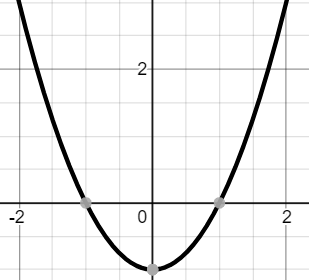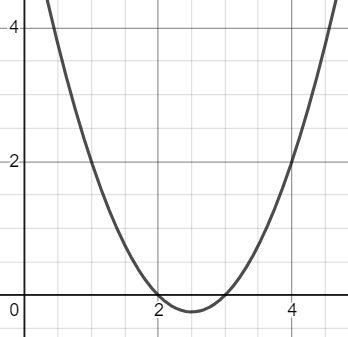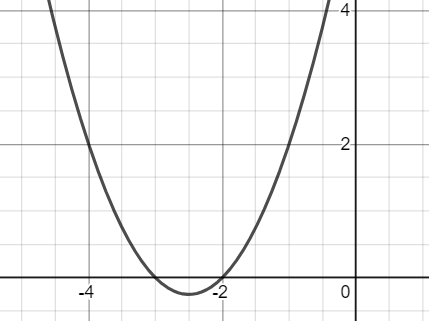
If one of the zeros of the quadratic polynomial of the form \[{{x}^{2}}+ax+b\] is negative of the other, then it
(a) has no linear term and the constant term is negative
(b) has no linear term and the constant term is positive
(c) can have a linear term but the constant term is negative
(d) can have a linear term but the constant term is positive.
Answer
597.3k+ views
Hint: We will first write the general form of the quadratic equation as a product of linear terms containing their roots. Then we will put in the required conditions and obtain the answer.
Complete step-by-step answer:
Let us now begin with the solution.
There are three types of quadratic polynomials with the real roots. All of them are shown below.

First type: one of the roots is negative

Second type: Both roots are positive

Third type: Both roots are negative
But in the question we deal with the polynomial which has one of the roots negative of the other.
Therefore, we deal with the first type.
Now we now that any quadratic polynomial can be written as a product of linear polynomials of their roots
\[{{x}^{2}}+ax+b=\left( x-p \right)\left( x-q \right)\] , where p and q are the zeros of the polynomial \[{{x}^{2}}+ax+b\] .
Now, as one of the roots is negative of the other let us assume the values of p and q.
Let p=a and let q=-a, where a is always a positive number.
Thus the equation becomes,
\[\begin{align}
& {{x}^{2}}+ax+b=\left( x-a \right)\left( x-\left( -a \right) \right) \\
& {{x}^{2}}+ax+b=\left( x-a \right)\left( x+a \right) \\
\end{align}\]
Multiplying we get,
\[{{x}^{2}}+ax+b=\left( x\times x \right)+\left( x\times a \right)+\left( -a\times x \right)+\left( -a\times a \right)\]
Taking out x as common, we get
\[{{x}^{2}}+ax+b={{x}^{2}}+x\left( a-a \right)-{{a}^{2}}\]
which means,
\[{{x}^{2}}+ax+b={{x}^{2}}+0x-{{a}^{2}}\]
Thus comparing we get b = 0 and c = -a2.
Thus the linear term becomes 0 and the constant term becomes negative.
Thus option(a) is correct.
Note: Please remember that a is always a positive number. If we take it to be any real number, then the constant term would become either positive or negative. Also, the linear would not become zero. Thus it will create a lot of confusion and our answer might go wrong.
Complete step-by-step answer:
Let us now begin with the solution.
There are three types of quadratic polynomials with the real roots. All of them are shown below.

First type: one of the roots is negative

Second type: Both roots are positive

Third type: Both roots are negative
But in the question we deal with the polynomial which has one of the roots negative of the other.
Therefore, we deal with the first type.
Now we now that any quadratic polynomial can be written as a product of linear polynomials of their roots
\[{{x}^{2}}+ax+b=\left( x-p \right)\left( x-q \right)\] , where p and q are the zeros of the polynomial \[{{x}^{2}}+ax+b\] .
Now, as one of the roots is negative of the other let us assume the values of p and q.
Let p=a and let q=-a, where a is always a positive number.
Thus the equation becomes,
\[\begin{align}
& {{x}^{2}}+ax+b=\left( x-a \right)\left( x-\left( -a \right) \right) \\
& {{x}^{2}}+ax+b=\left( x-a \right)\left( x+a \right) \\
\end{align}\]
Multiplying we get,
\[{{x}^{2}}+ax+b=\left( x\times x \right)+\left( x\times a \right)+\left( -a\times x \right)+\left( -a\times a \right)\]
Taking out x as common, we get
\[{{x}^{2}}+ax+b={{x}^{2}}+x\left( a-a \right)-{{a}^{2}}\]
which means,
\[{{x}^{2}}+ax+b={{x}^{2}}+0x-{{a}^{2}}\]
Thus comparing we get b = 0 and c = -a2.
Thus the linear term becomes 0 and the constant term becomes negative.
Thus option(a) is correct.
Note: Please remember that a is always a positive number. If we take it to be any real number, then the constant term would become either positive or negative. Also, the linear would not become zero. Thus it will create a lot of confusion and our answer might go wrong.
Recently Updated Pages
Master Class 12 Economics: Engaging Questions & Answers for Success

Master Class 12 Maths: Engaging Questions & Answers for Success

Master Class 12 Biology: Engaging Questions & Answers for Success

Master Class 12 Physics: Engaging Questions & Answers for Success

Master Class 8 Maths: Engaging Questions & Answers for Success

Class 8 Question and Answer - Your Ultimate Solutions Guide

Trending doubts
Why is there a time difference of about 5 hours between class 10 social science CBSE

Write a letter to the principal requesting him to grant class 10 english CBSE

What is the median of the first 10 natural numbers class 10 maths CBSE

The Equation xxx + 2 is Satisfied when x is Equal to Class 10 Maths

Which of the following does not have a fundamental class 10 physics CBSE

State and prove converse of BPT Basic Proportionality class 10 maths CBSE




